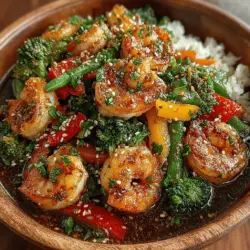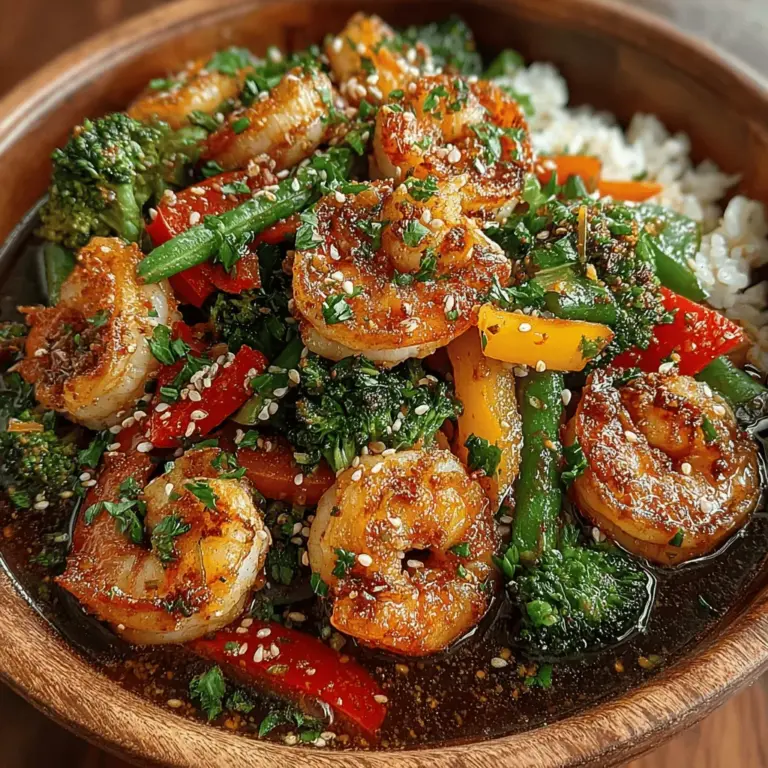Savory Shrimp and Vegetable Stir-Fry Bowls: A Delicious and Nutritious Weeknight Meal
When it comes to quick, healthy, and satisfying meals, few dishes can compete with a well-prepared stir-fry. Our Savory Shrimp and Vegetable Stir-Fry Bowls are not only vibrant and appealing, but they also pack a nutritional punch, making them a favorite choice for busy weeknights. This dish offers a delightful combination of succulent shrimp and a colorful array of vegetables, all tossed together in a flavorful sauce that will tantalize your taste buds. Whether you’re a busy professional, a parent juggling multiple responsibilities, or simply someone looking for a wholesome meal option, this stir-fry is the answer.
Incorporating a variety of vegetables and lean protein into your diet is crucial for maintaining a balanced lifestyle. Shrimp, a high-quality source of protein, boasts a low calorie count while providing essential nutrients such as selenium and vitamin B12. Pairing shrimp with an assortment of fresh vegetables not only enhances the dish’s flavor and texture but also contributes to your daily intake of vitamins and minerals. With just a few simple ingredients and minimal preparation time, you can whip up this dish in under 30 minutes, making it an ideal option for those hectic evenings when you want something delicious without spending hours in the kitchen.
Understanding the Ingredients
Before diving into the preparation of our Savory Shrimp and Vegetable Stir-Fry Bowls, it’s essential to understand the key ingredients that make this dish come alive. Each component plays a vital role in creating a balanced meal that is both flavorful and nutritious.
Shrimp: Nutritional Benefits and Flavor Profile
Shrimp is the star of this stir-fry, offering not only a delectable taste but also numerous health benefits. This seafood is low in calories and high in protein, making it an excellent choice for those looking to maintain or lose weight while still feeling satisfied. Shrimp is rich in omega-3 fatty acids, which are essential for heart health, as well as antioxidants like astaxanthin, which can help reduce inflammation. From a culinary perspective, shrimp has a mild, slightly sweet flavor that pairs beautifully with a variety of seasonings and cooking methods. Its quick cooking time makes it a convenient protein option that absorbs flavors exceptionally well, making marination crucial for the best results.
Vegetables: Importance of Variety for Health and Taste
A colorful mix of vegetables is what truly elevates this dish, not only in terms of visual appeal but also in nutritional value. In our recipe, we typically use a combination of broccoli, bell peppers, carrots, and sugar snap peas. Each of these vegetables brings unique textures and flavors to the table.
– Broccoli is rich in vitamins C and K and provides a satisfying crunch.
– Bell peppers add sweetness and vibrant color, along with a good dose of vitamin A and antioxidants.
– Carrots bring a natural sweetness while being an excellent source of beta-carotene, which is good for eye health.
– Sugar snap peas offer a crisp bite and a hint of sweetness, along with dietary fiber.
Using a variety of vegetables not only makes the dish more visually appealing but also ensures that you benefit from a wide range of nutrients essential for overall health.
Aromatics: The Role of Garlic and Ginger
No stir-fry would be complete without the aromatic duo of garlic and ginger. These ingredients are foundational in many Asian dishes, contributing depth and complexity to the overall flavor profile. Garlic is known for its strong flavor and health benefits, including its ability to boost the immune system and reduce blood pressure. Ginger, with its warm, spicy notes, adds a unique zing that complements the sweetness of the shrimp and vegetables. Together, these aromatics create a fragrant base that enhances the entire dish, making it truly irresistible.
Sauces: Key Components in Asian Cuisine
The right sauces can make or break a stir-fry, and in our Savory Shrimp and Vegetable Stir-Fry Bowls, we rely on a combination of soy sauce, oyster sauce, and sesame oil to create a savory and umami-rich flavor.
– Soy sauce is a staple in Asian cuisine, offering a salty, savory taste that enhances the natural flavors of the ingredients.
– Oyster sauce adds a rich, slightly sweet depth, made from oyster extracts, which is a fantastic complement to shrimp.
– Sesame oil provides a nutty aroma and flavor, bringing warmth and richness that rounds out the dish perfectly.
These sauces not only add flavor but also contribute to the glossy finish often associated with traditional stir-fried dishes.
Preparation Steps
Now that we’ve explored the essential ingredients, let’s dive into the preparation process. Following these steps will ensure that your Savory Shrimp and Vegetable Stir-Fry Bowls are not only delicious but also visually appealing.
Marinating the Shrimp: Importance and Effects of Marination
To enhance the flavor and tenderness of the shrimp, marinating is a critical step. A simple marinade made from soy sauce, garlic, and ginger can work wonders. Combine these ingredients in a bowl, add the peeled and deveined shrimp, and let them soak for about 15-20 minutes. This brief marination time allows the shrimp to absorb the flavors while also helping to tenderize the meat. The result is shrimp that is not only flavorful but also succulent and juicy when cooked.
Chopping and Preparing Vegetables: Techniques for Efficiency and Presentation
While the shrimp is marinating, it’s time to prepare the vegetables. Start by washing and drying each vegetable thoroughly. For the broccoli, cut it into bite-sized florets; for the bell peppers, remove the seeds and slice them into thin strips; for the carrots, peel and julienne them into matchstick-sized pieces; and for the sugar snap peas, simply trim the ends.
To ensure efficiency in cooking, it’s essential to have all your vegetables prepped and ready to go before you start stir-frying. This not only streamlines the cooking process but also helps maintain the vibrant colors and crisp textures of the vegetables, which are crucial for both taste and presentation.
Making the Stir-Fry Sauce: Balancing Flavors and Achieving the Desired Consistency
While the shrimp marinates and the vegetables are prepped, it’s an excellent time to prepare the stir-fry sauce. In a small bowl, combine soy sauce, oyster sauce, and a drizzle of sesame oil. Depending on your taste preferences, you might want to add a pinch of sugar to balance the flavors, especially if you like a hint of sweetness in your stir-fry. Mixing these ingredients together will ensure that they are well-combined and ready to be added to the hot stir-fry later on.
Cooking Techniques
With all the ingredients prepped, it’s time to talk about the cooking techniques that will take your Savory Shrimp and Vegetable Stir-Fry Bowls to the next level.
Importance of Using High Heat and the Right Equipment
Stir-frying is a cooking method that relies on high heat to quickly sear the ingredients, locking in flavors and maintaining the vibrant colors and textures of the vegetables. This technique is best accomplished with a wok or a large skillet, as both allow for even heat distribution and provide ample room for tossing the ingredients without overcrowding.
Choosing the Right Pan: Benefits of a Wok Versus a Skillet
While a skillet can work in a pinch, a wok is traditionally favored for stir-frying due to its unique shape, which allows for better heat distribution and the ability to cook food quickly while retaining moisture. The high sides of a wok also make it easier to toss ingredients without spilling them over the edge, ensuring that everything gets cooked evenly.
Stir-Frying: Explanation of the Technique and Its Benefits for Cooking Shrimp and Vegetables
To achieve the perfect stir-fry, start by heating your oil in the wok or skillet until it is shimmering hot. Add the marinated shrimp first, allowing them to sear for a couple of minutes until they turn pink and opaque. Then, add the prepped vegetables, starting with those that take longer to cook, like broccoli and carrots, followed by the bell peppers and sugar snap peas. The key to successful stir-frying is to keep everything moving in the pan, allowing the ingredients to cook evenly while retaining their crunch. This not only prevents burning but also promotes even cooking, resulting in a delicious medley of flavors and textures.
As you continue to stir-fry, add the prepared sauce and allow it to coat the shrimp and vegetables, creating a glossy finish that enhances both the appearance and flavor of the dish. The final result will be a stunning, savory bowl of shrimp and vegetables that is sure to impress anyone at your dinner table.
Stay tuned for the next part of this article, where we will explore serving suggestions and additional tips for customizing your Savory Shrimp and Vegetable Stir-Fry Bowls to suit your preferences.

Timing in Cooking: Ensuring Shrimp Are Perfectly Cooked and Vegetables Retain Their Crunch
Achieving the perfect balance in a stir-fry, especially when it includes shrimp and a medley of vegetables, hinges on timing. The key to ensuring shrimp are tender and juicy while vegetables maintain their crispness lies in the order of cooking and the heat level.
Cooking Shrimp to Perfection
Shrimp cook rapidly, usually requiring only 2-3 minutes on high heat. As soon as they turn pink and opaque, remove them from the heat to prevent overcooking, which can lead to a rubbery texture. Stir-frying at high temperatures allows for quick cooking, which helps shrimp retain moisture and flavor.
Preserving Vegetable Crunch
For the vegetables, it’s essential to add them in stages based on their cooking times. Start with heartier vegetables like bell peppers and broccoli, which can withstand a bit more heat. Add quicker-cooking vegetables, such as snow peas or spinach, towards the end of the cooking process. This method ensures that each component is cooked to its ideal texture without losing its vibrant color or nutritional value.
Combining Flavors and Textures
The stir-frying method not only cooks the ingredients quickly but also enhances the integration of flavors. Here’s how the cooking process contributes to a delicious outcome:
Enhancing Flavor Integration
As the shrimp and vegetables are cooked together in a hot wok or skillet, their natural juices intermingle. This brief cooking time allows for a harmonious blend of flavors without the ingredients becoming mushy. Each bite will provide a burst of shrimp taste alongside the freshness of the vegetables.
The Role of Stir-Fry Sauce
The sauce is the heart of any stir-fry. A well-balanced stir-fry sauce not only adds moisture but also a depth of flavor. For this recipe, a combination of soy sauce, garlic, ginger, and a touch of honey or brown sugar creates a savory and slightly sweet profile that complements the shrimp and vegetables perfectly. Toss the stir-fry sauce into the pan towards the end of cooking to ensure the flavors penetrate the ingredients without overpowering them.
Tips for Texture and Taste Balance
– Heat Control: Ensure your cooking surface is hot enough before adding the ingredients. This prevents steaming and promotes that coveted stir-fried texture.
– Sauce Timing: Add the stir-fry sauce towards the end, allowing just enough time for it to coat the shrimp and vegetables without making them soggy.
– Crisp Vegetables: Consider blanching heartier vegetables briefly before stir-frying; this technique ensures they remain crisp while still absorbing flavors.
Serving Suggestions
Presentation can elevate your dish from simple to spectacular. Here are some ideas to consider when serving your shrimp and vegetable stir-fry bowls:
Presentation Ideas
Serve your stir-fry in deep bowls to allow for a generous helping. A colorful arrangement of shrimp and vegetables adds visual appeal. Consider layering the ingredients: start with a base of rice or quinoa, then pile on the stir-fried mixture, finishing with a sprinkle of sesame seeds and sliced green onions.
Pairing with Rice or Quinoa
Both rice and quinoa serve as excellent bases for this dish. Rice, particularly brown rice, offers a nutty flavor and a chewy texture that complements the stir-fry. Quinoa, on the other hand, is a protein-rich grain that adds a delightful crunch and is gluten-free. Both options provide essential carbohydrates, making your meal satisfying and energizing.
Garnishing for Added Flavor and Texture
To enhance both the flavor and appearance of your dish, garnishing is key. A sprinkle of toasted sesame seeds adds a delightful crunch, while finely chopped green onions introduce a fresh, mild onion flavor. For an extra kick, consider adding a drizzle of sriracha or a squeeze of lime juice before serving.
Nutritional Breakdown
This savory shrimp and vegetable stir-fry is not just delicious but also packed with nutrients. Here’s a closer look at the health benefits and nutritional content:
Health Benefits of Shrimp and Vegetables
Shrimp are a powerhouse of protein, low in calories and fat while being rich in essential nutrients like selenium, vitamin B12, and iodine. The vegetables contribute an array of vitamins, minerals, and antioxidants, making this dish a well-rounded meal option. Including a variety of colorful vegetables ensures a broader range of nutrients.
Caloric and Nutritional Analysis Per Serving
A typical serving of this shrimp and vegetable stir-fry (about 1.5 cups) contains approximately 300-350 calories, depending on the amount of sauce and rice or quinoa used. Here’s a breakdown:
– Protein: 25-30 grams (from shrimp and quinoa)
– Carbohydrates: 40-50 grams (from rice or quinoa)
– Fat: 10-12 grams (healthy fats from sesame oil)
– Fiber: 5-7 grams (from vegetables and quinoa)
Healthy Choice for Various Diets
This dish fits well within various dietary preferences:
– Low-Carb: Substitute rice with cauliflower rice for a low-carb version.
– High-Protein: The shrimp and quinoa combination makes this a perfect choice for those seeking protein-rich meals.
– Gluten-Free: Using gluten-free soy sauce ensures that your stir-fry remains accessible to those with gluten sensitivities.
Variations and Customizations
This stir-fry recipe is highly adaptable, allowing for personal touches based on dietary needs and preferences.
Ingredient Substitutions
– Vegetarian Option: Replace shrimp with tofu or tempeh for a plant-based alternative. Both options absorb flavors well and provide protein.
– Vegetable Variations: Feel free to experiment with seasonal vegetables such as zucchini, carrots, or snap peas. Each offers unique flavors and textures.
– Spice It Up: For those who enjoy heat, add red pepper flakes or a dash of chili sauce to the stir-fry sauce.
Exploring Additional Sauces and Spices
The stir-fry sauce can be customized further. Consider adding:
– Hoisin Sauce: For a sweeter, more robust flavor.
– Oyster Sauce: To enhance umami notes.
– Coconut Aminos: A soy sauce alternative that is lower in sodium for those on a restricted salt intake.
Conclusion
In summary, these savory shrimp and vegetable stir-fry bowls offer a quick, healthy, and mouthwatering meal option that can easily be customized to suit a variety of tastes and dietary needs. The balance of perfectly cooked shrimp, vibrant vegetables, and a flavorful sauce creates a dish that is not only satisfying but also beneficial for your health.
Don’t hesitate to experiment with different ingredients, sauces, and garnishes to make this recipe your own. Home cooking is a joyful experience that allows you to explore flavors and nourish yourself and your loved ones with wholesome meals. Enjoy the process, and remember, the satisfaction of a homemade dish is truly unparalleled.


